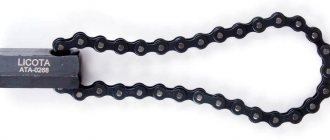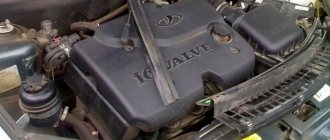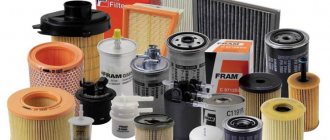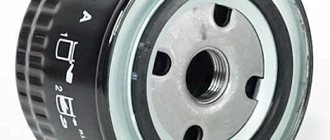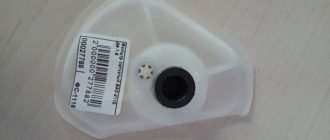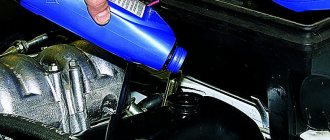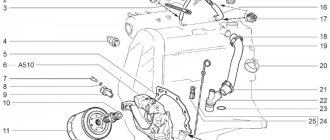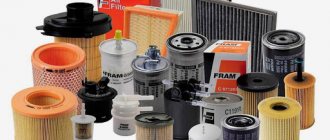| № | Name | Rating | Nomination |
| 1 | MANN FILTER W 914/2 | 4.65 | The most popular |
| 2 | MAHLE OC384 | 4.55 | High quality build |
| 3 | LADA 21080-1012005-08 | 4.50 | Reliability and quality |
| 4 | FILTRON OP 520/1 | 4.45 | The most affordable |
| 5 | GOODYEAR GY1102 | 4.30 | The best balance of price and quality |
Moving and rubbing engine parts wear out greatly at high temperatures. Motor oil cools and cleanses them of waste products. In turn, the oil filter removes metal shavings, contaminants, waste products and impurities from the engine lubricant. This allows you to maintain the quality of motor lubrication at the proper level.
The oil filter, according to the manufacturer's regulations, needs to be changed every 14-15 thousand km and after break-in (3000 km). But caring drivers do this already at 10-12 thousand due to the difficult urban operating conditions of the car. Replace the oil filter in parallel with the oil.
They differ in seating dimensions, quantity and quality of filter material (the size of the filter depends on this) and bypass valve pressure. For Lada Vesta 1.8 and 1.6 (cross, sedan), filters with an internal diameter of the seat ring of 62 mm, an external diameter of the ring of 71 mm and a thread of ¾-16 UNF are suitable.
Drivers of the Lada Vesta (cross, sedan) most often choose the MAHLE, MANN brands or the LADA branded filter. But there are also other models with good filtering capabilities.
Change of oil
It is better to change the lubricant when the engine is warm - liquid hot oil drains faster and with almost no residue.
The car must be lifted with a car lift (after opening the hood and removing the cap from the oil filler neck) or installed on an overpass or installation pit.
The configuration of the crankcase protection provides access to the drain neck to drain the old oil, but replacing the oil filter is not possible, so the protection must be removed by unscrewing the 13 bolts that secure it to the housing with a 10mm wrench.
It is better to put the bolts in a can of gasoline for cleaning and subsequent lubrication before installing them in place.
After completely dismantling the protection, you need to unscrew the drain plug with an 8-point hexagon, but not immediately all the way - the last couple of turns are done by lifting the container for old oil to it so that the stream does not go past.
Lada Granta oil filter replacement at 6000 km or how to change the oil filter correctly
The day has come to replace the oil filter.
how to change
the oil filter
correctly. Lada Granta drove 6000...
How to change the oil filter
The Lada Vesta with a robotic transmission has a drain plug of a different size, and the crankcase has a different design.
At the last revolutions of the plug, when removing it, precautions must be taken to avoid getting burned by the hot oil jet.
Having installed the tub on the floor in place, they begin to remove the old oil filter. Next to the filter there is a crankshaft sensor, which, in order to avoid damage when removing the filter, must be removed with a 10mm spanner, having first disconnected the plug with the wiring from it.
After removing the crankshaft sensor, they begin to remove the old oil filter - tighten it with a puller chain and make a half turn counterclockwise to unscrew it, after which the part is rotated by hand without effort.
If a puller is not found, then the filter is simply pierced through with a screwdriver, which is then used as a lever for rotation. By this time, the oil from the crankcase should be drained, and the container should be placed under the oil filter.
When removing the oil filter with a screwdriver, it must be pierced in the upper part so as not to damage the threads of the engine fitting.
After removing the old filter, they also give time for the oil to drain and begin installing the new one. The threads on the cylinder block pipe are cleaned with a rag, the new filter is filled approximately 50% with clean oil and the rubber sealing gasket is lubricated with it. The new filter is screwed until the rubber gasket contacts the block, after which the part is turned another ¾ of a turn manually, without using tools, the crankshaft sensor is installed and the wiring plug is connected to it.
The oil plug and the vulcanized washer on it are inspected for damage, if necessary, replaced with a new one or thoroughly cleaned of dirt, especially the threaded part, and then screwed tightly into the socket.
New motor oil in the required quantity is poured into the engine through the oil intake neck from above in portions, which is given time to drain into the crankcase, and its level is measured using a dipstick - to the upper edge of the corrugated part of the measuring section.
Then, closing the oil intake neck with a lid, start the engine, making sure that after 1-2 seconds the oil pressure warning lamp on the instrument panel goes out. After 2-3 minutes of idling, turn off the engine and after 5-10 minutes check the level on the dipstick. If the oil is less than the upper edge of the grooved zone, it is added. If the level is exceeded, then it needs to be lowered to normal - this can be done with a 20-gram syringe with a flexible tube from a medical dropper through the hole in the probe block.
Measurements of the engine oil level should be made while the vehicle is parked on a flat, horizontal platform, the slope of which should not exceed 2 degrees.
The operation is completed by installing the crankcase protection in place on bolts that have been cleaned and lubricated with lithol.
Design and principle of operation of the part
Sample engines that are used in modern car models include a lot of mechanisms rubbing against each other. Operating in this extreme mode, the mechanisms require high-quality lubricant as motor oil. For the rational operation of the engine and its components, the use of high-quality oil filters and timely replenishment of the oil reservoir with the missing amount of liquid are required.
In order for the car to remain operational for a long time, it is necessary to monitor the condition of the spare part and the level of engine oil. Manufacturers of car parts for Vesta and other models offer a wide range of filters. They may look different, but the products do the same job, they have a single mechanism of action. The part cleans the lubricant, removes dirt and metal particles from engine parts and prevents them from getting back into the operating mechanism.
The filter component of the Lada Vesta car is visually similar to filters of other brands - it looks like a dark glass with a cleaning device in the middle. Despite its apparent simplicity, the part has a complex design.
Components
- Glass-shaped shell;
- Filter device in the middle. It is made of a kind of thick cardboard. It is folded a large number of times into an accordion and rolled into a “roll”. The material is treated with an absorbent substance;
- Spring;
- Two valves: bypass, non-return;
- Several entrances and one exit from the opposite side;
- Sealing material on top that prevents liquid from spilling.
Car owners should note that if one component of the filter element breaks down, the entire part must be replaced. Its further operation is impossible.
Find out everything about: oil filter for Lada Vesta car
The oil filter for a car is an important element of the engine compartment. Cleaning the motor fluid from contaminants that reduce the quality of the fluid from impurities is what an oil filter does. Lada Vesta allows you to fill a wide range of oils into the engine, and the operation of the entire engine and its individual components depends on how successfully it copes with the task. The oil filter for the Lada Vesta car, which is installed at the factory - with the catalog number (article) AvtoVAZ 2105-1012005-82, is good, but car enthusiasts try to replace it at the first opportunity - stereotypes that foreign parts are better - this is not always the case. The car uses a brand filter: Livny, BIG GB-102M, BOSCH 0 451 103 274, Mann, models are suitable for all VAZ cars. Read the article to the end and you will find out: the article number of the Lada Vesta oil filter, how it works, what it consists of and when to change it. Necessary consumables for replacement, brand of filter that is installed on the Lada Vesta, tools for work.
Good non-original filters: articles, price
Specifications (size):
- outer diameter: 84.7 mm;
- screw thread: M20x1.5;
- internal diameter: 61.1 mm.
| Article number (oil filter) | Price in rubles | ||
| H13W01 | PH6811 | W 811/80 | From 430 – 470 |
| C-1016 | TF 24 | LC-331 | From 430 – 470 |
| PF4076 | CMZ11431 | LS489A | From 430 – 470 |
| W811/80 | COF100119S | ADS72101 | From 430 – 470 |
| HU 7001 x | OF 1101 | 451103316 | From 430 – 470 |
| 1ECO076 | H13W01 | OP617 | From 430 – 470 |
| 10498 | E825H D265 | N1310510 | From 430 – 470 |
| C-1016 | PH6811 | DO 324 | From 430 – 470 |
| CMZ11431 | EOF251 | PF4076 | From 430 – 470 |
| OX 351D | ADS72101 | LS489A | From 430 – 470 |
| 10-04-498 | OX 351D | 0 451 103 316 | From 430 – 470 |
| *prices are as of July 2022 |
How much oil to fill in the Lada Vesta SV Cross engine
First generation 2181, since 2017
Compared to the standard station wagon, the Vesta SV Cross version is distinguished by increased ground clearance (+20 mm, total 203 mm), and protective plastic body kits around the perimeter of the body. A similar interior has been transformed with bright colored inserts on the seats and front panel. The car is equipped with original 17-diagonal wheels. In addition, another design element is a silver trim under the rear bumper, as well as a chrome-plated dual silencer. The car is available in the maximum “Lux” configuration with all additional options, among which are ESP, ABS, start and lift assistance, airbags (front and side), emergency alarm, ERA-GLONASS, light and rain sensors, cruise control, climate control, etc.
Also read: Motor oil for Toyota Platz engine
Gasoline engines from 2017
- 1.6 106 l. With. (21129), oil volume - 4.4 liters (or 3.2 liters - with AMT), tolerance and viscosity: API-SN; SAE 5W-40, 0W-40, 0W-30, 10W-40, 10W-30
- 1.8 122 l. With. (21179), oil volume - 4.4 liters, tolerance and viscosity: API-SN; SAE 5W-40, 0W-40, 0W-30, 10W-40, 10W-30
How to distinguish a fake from an original filter on a Lada Vesta
You can purchase consumables in various places, namely:
- at the car market;
- in a specialized store;
- in online catalogues;
- through intermediaries.
Given the breadth of choice, for an inexperienced owner the risk of purchasing non-original products increases due to insufficient knowledge of unmasking factors.
When selecting consumables, be sure to check the availability of:
- branded cardboard packaging, its integrity;
- holographic protection from the front of the package;
- factory stamp with batch number, date of manufacture, country of origin;
- rubber seal on the inner diameter of the MF.
When purchasing, check for a quality certificate or other documentary materials indicating the origin of the product. If you have any doubts about the product, refuse it.
When is it necessary to replace the MF on a Lada Vesta
- the scheduled period for technical inspection has arrived (20,000 km);
- the presence of a crack, traces of deformation of the body after an impact, a collision with a road obstacle, or an oncoming car;
- after starting the engine, the indicator on the instrument panel does not go out for a long time - the engine oil pressure warning lamp;
- under the bottom of the car in the area where the MF is located, traces of liquid leakage are visible.
Recommendations for selection
Purchase consumables exclusively for the brand of your car. Use the services of official sales points, representative offices, dealer centers.
Check integrity, tightness, absence of defects and damage. The deeper the warehouses, the better the cleaning. The base of the cleaner must be metal. Various analogues and substitutes are unacceptable.
Carefully check the catalog numbers, date, and batch number on the packaging.
Conclusion
Individual standards for oil, filter, and other consumables have been developed for each technical product. The purchase of original components guarantees long-term and trouble-free operation of the machine. Saving on maintenance entails negative consequences, including major repairs.
The process of replacing the oil filter is simple. If you have tools and consumables, prevention will take no more than 15 minutes. You should contact the service center only in case of emergency or major breakdown.
Step-by-step replacement process
Preparatory stage, necessary tools:
- chain puller - key;
- head at “10”;
- hexagons on “8”, “17”;
- new oil purifier;
- rags;
- empty container for draining waste;
- synthetic based motor oil;
- additional lighting if daylight is not enough.
Replacement algorithm
- We install the car within the perimeter of the repair area, provide safety measures, and secure the rear row of wheels with wheel chocks.
- Warm up the engine to operating temperature and turn it off.
- We remove the metal protection from under the bottom and unscrew the 13 screws around the perimeter. Subsequently, we clean the plate from dirt and waste products.
- Unscrew the drain plug with an “8” hexagon and grind the waste oil into a container. Only 4.4 liters for manual transmission and 3.8 liters for automatic transmission. Screw the plug.
- Using a chain puller, twist the cleaner and wipe the perimeter from oil and dirt.
- Pour 100 - 150 ml of oil into the new filter and install the cleaner in its original place. Tighten moderately, without excess.
- Fill the filler neck of the valve cover with oil at a level of 4.4 or 3.8 liters, depending on the type of pre-installed gearbox.
- We start the engine, the indicator on the dashboard should go out.
- We check for drips and lubricant leaks. We make a control measurement of the level.
The best semi-synthetic oils for Lada Vesta
After the warranty period expires, you can switch to semi-synthetic oil. It has proven itself well in European winter conditions, when the air temperature in winter rarely drops below -20°C. Experts have selected several suitable motor oils.
SHELL Helix HX7 10W-40
SHELL Helix HX7 10W-40 semi-synthetic product deserved the most flattering words from experts. It combines affordability with a long service life. If most competitors manage to make semi-synthetic oil with a service life of 5 thousand km, then SHELL Helix HX7 can be changed after 7 thousand km. The advantages of the lubricant include maintaining fluidity at low temperatures. The product received all these properties thanks to the combination of a synthetic and mineral base. It should also be noted that there are unique detergent additives that keep the Lada Vesta engine perfectly clean.
Semi-synthetics win our rating for durability, versatility of use and reasonable price. You should only buy it from trusted suppliers due to the presence of counterfeit products on the market.
Flaws
When developing semi-synthetic oil Castrol Magnatec 10W-40 R, the British manufacturer was guided by Russian climatic conditions. This approach did not go unnoticed by our experts, who recommend using the product in Lada Vesta. The low thickening temperature deserves special praise; even at -35°C the lubricating fluid retains its fluidity. Numerous tests have confirmed the frost resistance of the material, for which it occupies the second line of our rating.
Oil filter for Lada Vesta: description
The oil filter on Lada Vesta serves to carry out high-quality cleaning of engine lubricant from dirt and impurities that reduce pressure, viscosity and quality of the oil. It differs in size, mounting, opening pressure of the bypass valve, depending on the year of manufacture. It has its own unique design features.
Design features and location
The oil filter has a metal base of various shapes (often presented in the form of a multifaceted glass), a paper filler, which is folded like an accordion and impregnated with a special substance. Also equipped with a pressure spring, bypass check valve, exhaust port and rubber seal.
Located at the bottom of the engine compartment on the right. You can approach it from under the bottom of the car, through the top.
During replacement, you should use a special chain wrench that serves as an oil filter element remover. When the engine is running, the temperature rises, and the rubber seal is attached tightly to the cylinder. As a result, it is impossible to pick it up with your hands. There is a risk of serious burns.
Principle of operation
The engine includes a large number of moving parts that rub against each other when the car is running. When working at high temperatures, the friction force increases. The wear and tear of all mechanisms increases. Motor oil removes excess heat and cleans surfaces of waste products. The filter allows oil to pass through using a filler. This process is continuous until the power unit is stopped.
Consumable service life
According to the regulations from the manufacturer, the consumable will serve until the car reaches 14 thousand kilometers traveled. It will also serve up to 3 thousand kilometers during the first maintenance. In practice, the service life of a consumable is reduced by half due to climatic conditions, increased dust, gas contamination, low quality fuel, motor fluid and cleaner.
It is worth pointing out that the service life of a consumable directly depends on the quality of the engine oil, its viscosity coefficient and standard labeling. It also depends on the driving style of the motorist, the temperature conditions of the car, the tightness of the cooling system, the integrity of the cylinder head gasket and the quality of the cleaner.
Signs of wear and clogging
Signs of wear and clogging include the appearance on the dashboard of a corresponding indicator indicating an engine breakdown, a low pressure indicator on a mechanical sensor, damage and deformation of the metal body of the purifier due to depressurization and fluid leakage. Also a sign of the need to replace the oil filter is the appearance of an unpleasant odor and leaks under the bottom.
When to change
In accordance with the manufacturer's regulations, scheduled replacement is every 14,000 km, not including the first maintenance at around 3,000 km.
The box describes the models for which the part is suitable.
In practice, few owners adhere to the specified interval. Reasons for this:
- climatic conditions;
- increased dustiness;
- gas pollution;
- low quality of fuel, motor fluid, and the cleaner itself.
The average interval is 10 – 12 thousand km. The recommendation is for informational purposes only and is not a mandatory norm. If you love your car, you will still listen to the opinion of professionals.
Signs that replacement is needed
- an indicator on the dashboard indicates a malfunction in the engine;
- a mechanical sensor, if present, shows pressure below normal;
- The metal body of the purifier is damaged or deformed. Depressurization or fluid leakage has occurred;
- the scheduled replacement date has arrived;
- individual decision of the car owner about replacement.
Factors affecting replacement time
- quality of motor oil, its class, viscosity coefficient, API marking;
- driving style;
- temperature conditions of use;
- tightness of the cooling system, integrity of the cylinder head gasket;
- quality of manufacture of the purifier.
Filter life
The service life of an oil cleaner greatly depends on the operating conditions of the vehicle. Accelerated clogging of the filter element is greatly influenced by:
- climatic conditions and weather;
- dust and gas levels;
- quality of fuel and lubricants;
- condition of piston rings, oil valve caps and other engine parts.
When the piston rings are severely worn, gases from the cylinder break into the crankcase and change the composition of the oil. The result is substances that accelerate filter clogging.
If the valve stem seals are worn out, the oil enters the cylinder and burns there. The engine's consumption of lubricants increases, and substances are formed that contaminate the filter element.
https://youtube.com/watch?v=YdPz3oEXL8M%3F
The service life is greatly influenced by the quality of the cleaner itself. It is better to buy original spare parts. They are a little more expensive, but this is compensated by longer service life and reliability.
Cost of service in auto repair shops
As a rule, replacing the MF in auto repair shops is an inexpensive procedure, regardless of the make of the car. The final cost of the service depends on the type of brand, region, prestige of the auto repair shop and other parameters.
In general, the oil filter for the Lada Vesta is an element that is necessary to perform high-quality cleaning of the engine system from metal shavings with waste products, contaminants, and impurities that reduce pressure, viscosity and oil quality. The consumable has its own unique design features and long service life. It must be replaced independently according to the step-by-step instructions given above or with the help of specialists in order to avoid damage to the entire motor system.
↑ Where to buy and how much does an oil filter cost?
Lada Vesta is available with two engine options, 1.6 or 1.8 liters. But this does not in any way affect the choice of oil filter.
When assembling this vehicle, a Russian-made Livny brand device is installed. The price of this model was set at 140-150 rubles. But many Lada Vesta car owners are dissatisfied with the quality of this model. In most cases, they are not satisfied with the problem of oil leakage along the rolling circuit.
When passing an official technical inspection, technicians often install an original spare part with catalog number 21080101200582, manufactured by . The cost is about 250 rubles. Based on reviews from people who use Lada Vesta cars, this brand is much better than the Livna, which is installed during assembly.
In addition to the original filters listed above, their analogues are also very popular. The most famous of them:
- MANN W914/2. Manufactured by the German company MANN+HUMMEL. This is one of the most common brands among Russian motorists. The high quality of the paper, the filter impurities, and the proven check valve have allowed us to earn an excellent reputation from the owners of Lada Vesta. There is also additional protection against counterfeiting, consisting of a distinctive inscription on the bottom of the case, which can only be seen under the influence of ultraviolet rays. The cost starts from 180 rubles.
- FRAM PH5827. Are being manufactured. A distinctive feature is that the area of material with which the oil is purified is significantly increased due to the special design of the filter element, located in the shape of an “accordion”. But there is also one minor drawback. When starting the engine, the oil pressure light stops lighting only 2-4 seconds after it starts running. The price is 160 rubles or more.
- NF-1005. The production is carried out by Russian. The main positive feature is the valve design, which prevents the oil level from becoming too low. This can lead to overheating, faster wear and subsequently render the engine inoperable. The market price of this oil filter is about 100 rubles.
Due to the fact that the filter is a common consumable, purchasing it is not a problem, either at stationary points of sale of automobile spare parts (markets, auto stores), or ordering them on the website. Due to the relatively frequent need to replace them, oil purifiers for Lada Vesta are, in most cases, in stock, and you don’t have to wait for them to be delivered.
Do I need to flush the engine?
After changing the oil, flushing the engine is not always necessary: it is recommended to do this during the first change, and also if you purchased a used car and do not know what kind of oil was poured into it and when it was done.
The procedure will also be required when switching from one type of oil to another when the viscosity does not match, but this should only be done if the engine is quite dirty, for example, if low-quality oil was used or was changed at the wrong time.
It doesn’t hurt to do a flush if the engine is already quite old or the mileage has exceeded 100,000 km. This way you can remove excess deposits, what is stuck to the internal mechanisms and does not come out along with the waste.
Other cases do not require washing and can be neglected. In general, it is not recommended to do flushing too often, as it can wash away the protective oil layer, expose internal damage, chips, cracks that were previously closed and did not affect the operation of the engine.
Step-by-step replacement process
Preparatory stage, necessary tools:
- chain puller - key;
- head at “10”;
- hexagons on “8”, “17”;
- new oil purifier;
- rags;
- empty container for draining waste;
- synthetic based motor oil;
- additional lighting if daylight is not enough.
Replacement algorithm
- We install the car within the perimeter of the repair area, provide safety measures, and secure the rear row of wheels with wheel chocks.
- Warm up the engine to operating temperature and turn it off.
- We remove the metal protection from under the bottom and unscrew the 13 screws around the perimeter. Subsequently, we clean the plate from dirt and waste products.
- Unscrew the drain plug with an “8” hexagon and grind the waste oil into a container. Only 4.4 liters for manual transmission and 3.8 liters for automatic transmission. Screw the plug.
- Using a chain puller, twist the cleaner and wipe the perimeter from oil and dirt.
- Pour 100 - 150 ml of oil into the new filter and install the cleaner in its original place. Tighten moderately, without excess.
Changing engine oil Lada Vesta
The most in demand is changing the lubricant in the power plant. The engine experiences constant loads and operates at high temperatures. This feature leads to wear of the lubricant and depletion of additives. The fact ensures the need to replace the working formula. To perform the operation correctly, you will need knowledge of several nuances.
What kind of oil to pour into the engine
From the factory, the car is delivered to the market with the Rosneft Magnum Maxtek 5W30 formula, which corresponds to the characteristics of the internal combustion engine. If such a liquid is not available, you can safely use oils:
- Mobil 5W40;
- Castrol Magnatec 5W30;
- Lukoil Lux 5B40.
You can also choose an analogue according to the parameters at your discretion.
- As a base, only hydrocracking semi-synthetics or completely artificial mixtures based on PAO or esters should be used. Fluids ensure high-quality engine operation and maintain optimal efficiency under increased loads.
- Viscosity is not important for the assembled structures - power plants do not differ in specific requirements. Consequently, lubricants can be selected from the general SAE table, where groups 5W30/5W are acceptable for the Russian climate
- It is also recommended to adhere to the API SM, ACEA A3/B3, AvtoVAZ tolerance groups. At the same time, it is permissible to fill in liquids exceeding the specified standards.
How much oil to pour into the Lada Vesta engine
Depending on the configuration, the service fluid volumes are as follows:
- 1.6/1.8 l automatic – 3.2 liters;
- 1.6/1.8 liters manual/robot – 4.4/4.1 liters.
How often to change
The manufacturer recommends changing the lubricant in the engine every 15,000 kilometers. The service interval is optimal for the design of the power plant and moderate operating conditions. In severe conditions (city traffic, off-road), the lubricant operating time should be reduced to 10,000 - 12,000 kilometers. At the same time, you should know that on the Lada Vesta the first oil change is performed already at around 2500 km.
Some car enthusiasts update even more often (about 7,000 km), which only extends the life of the power plant.
Changing the oil in the Lada Vesta engine
The sequence of actions is as follows.
- Warm up the engine and drive the car into the inspection pit.
- Prepare a container for draining the waste and the required tools.
- Open the filler neck, having first removed the plastic casing.
- From below, using head No. 10, unscrew the 13 bolts of the crankcase protective cover.
- Next, you need to place the prepared container under the drain hole and unscrew the lid.
- After draining the waste, you will need to remove the oil filter. The element can be removed by punching a hole in it and inserting a screwdriver into it, using it as a lever. You can also use a special chain whip.
- Install a new filter.
- Close the bottom plug.
- Pour the required amount of lubricant into the motor through the filler neck.
- Install the protective covers in reverse order.
Types of oil filters
Oil filtration systems are available in full-flow, partial-flow and combined types.
In a full-flow system, all the oil passes through the purifier. The cleaning speed is high, but if the filter element is clogged, the bypass valve directs the lubricant into the system without cleaning. This is exactly the oil filter found on the Lada Vesta.
In a partial flow system, only a portion of the lubricants passes through the filter element. Filtration is higher quality, but also slower.
Oil filter "Mann" for Lada Vesta. Photo source: https://stars-auto.com/catalog/i_14725
In a combined system, two filters are installed: full-flow and partial-flow. This system provides good oil cleaning and engine protection.
The Vesta full-flow oil filter consists of the following parts:
- Metal housing with several inlet holes and one threaded outlet.
- Cardboard filter element. To increase the filtration area, it is made corrugated or rolled into a roll.
- The bypass valve redirects the oil past the filter element. This can happen in winter when the oil is too viscous, or when it is very dirty and cannot be cleaned. In this case, contaminated lubricant reaches the parts, but this is better than working dry.
- The anti-drain valve prevents the oil from draining completely from the filter. This is necessary to supply lubricant to the line immediately after starting the engine.
- The sealing gasket ensures the tightness of the system.
There are also non-removable and serviceable oil purifiers. If the former are completely changed during maintenance, then only the filter cartridge is replaced for the latter.
Preparing tools and supplies
To replace the oil filter, you will need the filter itself. To select a filter for the Lada Vesta, experts recommend adhering to the following principles:
— purchase an oil filter element for a specific car model;
— purchase spare parts for oil filtration at trusted, reliable points;
- when choosing a product, pay attention to the depth of the folds - the deeper, the better;
- pay attention to the base - the material. The main part must be made of metal;
— make sure that the name and article on the package match.
Top 2. MAHLE OC384
Rating (2021): 4.55
34 reviews taken into account from resources: Otzovik, PartReview
High quality build
The popular filter attracts with its German thoroughness of assembly and stable operation.
- Characteristics Average price: 399 rub.
- Country: Austria
- Height, mm: 74
- Weight, g: 370
Drivers consider this oil filter one of the best for Lada Vesta. It does an excellent job of cleaning oil and works stably in cold weather. A well-placed filter element has a filtration area of 1023 square meters. see Not the greatest, but sufficient indicators. The opening pressure of the bypass valve here is 1.42 bar - it pushes through contaminated oil quite well. Car owners also noticed that the filter made in Indonesia (OS384A) is slightly inferior in quality to the Austrian one. Its body is slightly lower, the filtration area is smaller (800 sq. cm), the pressure is slightly lower, and the assembly is not as flawless.
Advantages and disadvantages
- High quality build
- Good valve opening pressure
- Stable operation in cold weather
The quality of Asian manufacturers is worse
Brief characteristics of filters
- Mann W914/2: German manufacturer, one of the main suppliers of consumables for Lada, VAZ. Good quality, affordable price, wide range for different models, but a large number of fakes;
- FRAMPH5822: Product of Sogefi Aftermarket. The cleaning element inside the structure is located in the form of an accordion, which improves cleaning and increases throughput. If there is insufficient pressure in the system, the warning indicator on the dashboard lights up;
- NF-1005: domestic. Not a bad budget option. There are no particular advantages or disadvantages.
For Lada Vesta 1.8 and Lada Vesta 1.6, the filters are identical in size and parameters. The engine displacement configuration has no effect on the design of the oil purifier.
What kind of oil filter is on the Lada Vesta: the factory (original) filter is of poor quality, does not hold pressure well, depressurization and oil leakage often occur. Many car enthusiasts install foreign analogues instead of the standard one.
- diameter (external / internal): 93 / 62 mm;
- pressure when opening the intake valve: 1.2 bar;
- thread diameter: 16 inches or ¾.
Reviews are positive and negative
| № | Positive |
| 1. | Gennady , 41 years old, service center employee: this is the second year since I bought the Lada Vesta, there are no special comments, I fix minor defects on my own. I've heard a lot of negative things about the oil cleaner, but I can't say anything bad. I use it myself and have no intention of switching to foreign analogues. |
| 2. | Vasily , 39 years old, manager: there are no complaints about the car, it’s always in good working order. I systematically carry out technical inspections and buy only original components and spare parts. Driving style is moderate. |
| 3. | Dmitry , 45 years old, taxi driver: a year and a half has passed since the purchase of the car. In general, everything is fine, breakdowns do occur, but they are insignificant and can be easily fixed. I buy domestic oils and filters; it is not advisable to overpay for a foreign brand. |
| 4. | Prokhor , 29 years old, private entrepreneur: I use my car very often, I drive a lot of kilometers. The working condition of the equipment is the most important thing for me. I periodically carry out maintenance, preventative maintenance, and replace consumables. I rarely contact the service; I rely on personal experience and knowledge. |
| Negative | |
| 5. | Kirill , 35 years old, doctor: I’ve heard a lot about the poor quality of production of the domestic Livny oil filter. After buying the car, I replaced it with a FRAM PH5822, it is the best among its analogues. The price is similar, but the guarantee is European. |
| 6. | Ivan , 41 years old, salesman: I use the car extremely rarely, mainly for trips out of town and fishing. I replace consumables ahead of schedule due to low mileage, which is obvious. I am skeptical about domestic oils and filters; I prefer foreign analogues, for example Fenox 4543544, it is better and of higher quality than the factory one. |
| 7. | Victor , 28 years old, private entrepreneur: I spend a lot of time on the road, visiting clients, concluding contracts. For me, the good condition of the car comes first. I carry out diagnostics according to the regulations, fill in high-quality oils, and buy German filters. |
| 8. | Alexander , 42 years old, foreman: the job is located at the end of the city, it takes a long time to get there by public transport, about an hour. The car is an indispensable assistant in this regard. The technical condition of the Lada Vesta is important to me; I take care of it and follow the manufacturer’s recommendations. I buy expensive consumables and trust domestic products least of all. |
| Video - Access to the oil filter |
Related link:
Replacing the low beam lamp on a Lada Vesta.
| Video - Vesta Pluto A few words about the oil filter |
